Advertisements
Advertisements
प्रश्न
What is the least distance of distinct vision for a normal human eye?
उत्तर
The least distance for distinct vision for a normal human eye is about 25 centimeters.
संबंधित प्रश्न
The human eye can focus objects at different distances by adjusting the focal length of the eye lens. This is due to ______.
Draw labelled diagrams of the following: Eye
Write short notes on the following: Retina
The size of the pupil becomes ______ when you see in dim light.
Draw a labelled sketch of the human eye.
Describe the anatomy of the human eye.
The optical prescription for a pair of spectacles is :
Right eye : −3.50 D
Left eye : −4.00 D
Which is the weaker eye?
A person got his eyes tested by an optician. The prescription for the spectacle lenses to be made reads :
Left eye : +2.50 D
Right eye : +2.00 D
State whether these spectacle lenses will converge light rays or diverge light rays.
Name the part of the eye:
on which the image is formed.
Where is the image formed in a human eye?
Name two types of cells in the retina of an eye which respond to light.
Name the part of our eyes which helps us to focus near and distant objects in quick succession.
If you walk from a dark room into sunlight and back again into dark room, how would your pupils alter in size? What makes this happen?
To focus the image of a nearby object on the retina of an eye:
(a) the distance between eye-lens and retina is increased
(b) the distance between eye-lens and retina is decreased
(c) the thickness of eye-lens is decreased
(d) the thickness of eye-lens is increased
An object is moved closer to an eye. What changes must take place in the eye in order to keep the image in sharp focus?
Explain why, when it is getting dark at night, it is impossible to make out the colour of cars on the road.
What is presbyopia? Write two causes of this defect. Name the type of lens which can be used to correct presbyopia.
A man driving a car can read a distant road sign clearly but finds difficulty in reading the odometer on the dashboard of the car. Which of the following statement is correct about this man?
(a) The near point of his eyes has receded away.
(b) The near point of his eyes has come closer to him.
(c) The far point of his eyes has receded away.
(d) The far point of his eyes has come closer to him.
What are the advantages of having two eyes instead of just one?
With both eyes open, a person's field of view is about:
(a) 90°
(b) 150°
(c) 180°
(d) 360°
The animals called predators have:
(a) both the eyes on the sides
(b) one eye on the side and one at the front
(c) one eye on the front and one at the back
(d) both the eyes at the front
The region in the eyes where the rods and cones are located is the
Mention, where in living organism is the following located and state their main function:
Fovea centralis
In what two ways is the yellow spot different from the blind spot?
State the main functions of the following:
Coronary Artery
Define the following:
Blind spot
Label the following diagram :
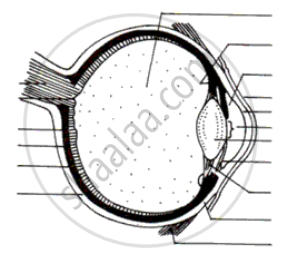
Give the main function of the following:
Three semicircular canals
The diagram alongside represents a certain defect of vision of the human eye.
(i) Name the defect.
(ii) Describe briefly the condition in the eye responsible for the defect.
(iii) Redraw the figure by adding a suitable lens correcting the defect. Label the parts through which light-rays pass.
(iv) What special advantage do human beings derive in having both eyes facing forward?
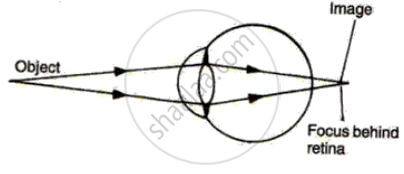
What is meant by power of accommodation of the eye?
Name the following:
The region in the eye where the rods and cones are located.
State the Location of:
Lacrimal gland
Complete the following sentence with appropriate Word
The part of the human eye where rod cells and cone cells are located is the:
The image of the object in the human eye is formed on the cross screen.
For a healthy human eye, the distant point is infinite distance.
The following figure show the change in the shape of the lens while seeing distant and nearby objects. Complete the figures by correctly labelling the diagram.
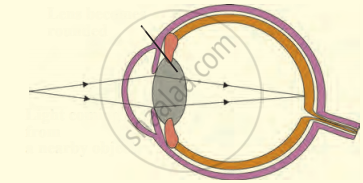
Complete the paragraph by choosing the right options given below.
(minimum, near point, 25 cm, farthest, farthest distance, far point)
The _______ distance of an object from a normal eye, at which it is clearly visible without stress on the eye, is called the minimum distance of distinct vision. The position of the object at this distance is called the _______ of the eye, for a normal human eye, the near point is at _______. The _______ distance of an object from a human eye, at which it is clearly visible without stress on the eye is called _______ of distinct vision. The position of the object at this distance is called the _______ of the eye.
Draw the struture of human eye and label its parts.
Assertion: Blind spot is a small area of the retina which is insensitive to light where the optic nerve leaves the eye.
Reason: There are no rods or cones present at the junction of the optic nerve and retina in the eye.
A prism ABC (with BC as base) is placed in different orientations. A narrow beam of white light is incident on the prism as shown in Figure . In which of the following cases, after dispersion, the third colour from the top corresponds to the colour of the sky?
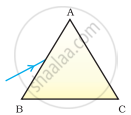 |
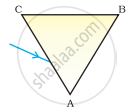 |
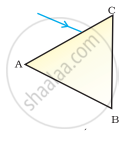 |
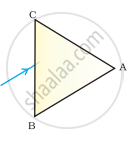 |
| (i) | (ii) | (iii) | (iv) |
In the figure of the human eye, the cornea is represented by the letter

Name the part of the eye which gives colour to the eyes.
What kind of lens is there in our eyes? Where does it form the image of an object?
What is ‘white of the eye’?
With neat, labeled diagram describe the structure of retina of eye.
Match the following:
| Column - I | Column - II |
| 1. Retina | a. Path way of light |
| 2. Pupil | b. Far point comes closer |
| 3. Ciliary muscles | c. near point moves away |
| 4. Myopia | d. Screen of the eye |
| 5. Hypermetropia | e. Power of accommodation |
